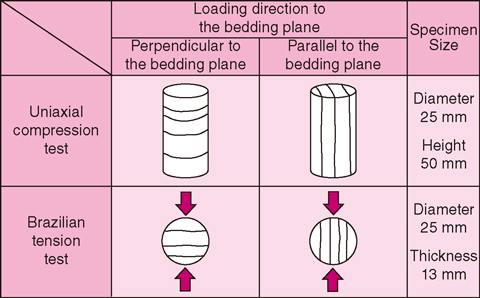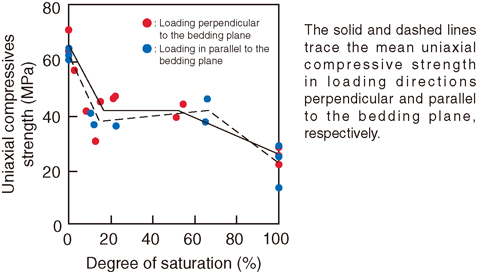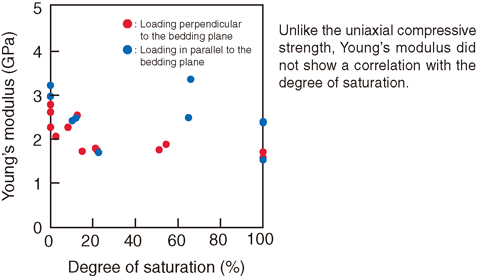Table 8-2 Specifications of specimens


Fig.8-25 Relation between uniaxial compressive strength and degree of saturation
Table 8-3 Results of the Brazilian tension test


Fig.8-26 Relation between Young’s modulus and the degree of saturation
Part of the research and development (R&D) program on the geological disposal of high-level radioactive waste has been conducted at the Horonobe Underground Research Laboratory (URL). A sample of the siliceous mudstone of the Wakkanai formation obtained from the URL has a high porosity of between 30% and 50%. Mechanical tests confirmed that the volume of the mudstone varies as a function of water saturation and that the moisture content may exert some control on the deformation and destruction behaviors of the mudstone.
The degree of water saturation in a rock mass changes when a gallery is excavated; hence, uniaxial compressive and Brazilian tension tests were performed to investigate the relation between moisture content and the mechanical properties of the rock mass. Furthermore, the mechanical properties of the rock mass in relation to the bedding planes and banded structures in the siliceous mudstone of the Wakkanai formation were also investigated.
Specimens of siliceous mudstone from the Wakkanai formation were obtained at depths of more than 300 m below the ground surface. Two kinds of specimens having loading directions either perpendicular or parallel to the bedding plane were used in uniaxial compression and Brazilian tension tests (Table 8-2).
Both uniaxial compressive strength (Fig.8-25) and Brazilian tensile strength (Table 8-3) were high in the dry state and decreased as the degree of water saturation became higher. Differences in water saturation, however, could not be distinguished in the Young’s modulus of stiffness (Fig.8-26). The uniaxial compressive strength and Young’s modulus in the compression state (Figs.8-25 and 8-26) were not affected by orientation with respect to the bedding plane. On the other hand, orientation with respect to the bedding plane could be recognized in the Brazilian tensile strength in the tension state (Table 8-3). The strength ratio in the loading direction (perpendicular/parallel) to the bedding plane was 1.4 in the water-saturated state and 1.5 in the dry state. It is believed that the characteristics of intact rock restrict the influence of the bedding plane upon the uniaxial compressive strength and Young’s modulus, and the ease of splitting the bedding plane is identified in the Brazilian tensile strength.
It was found that the mechanical characteristics of siliceous mudstone of the Wakkanai formation depended on the degree of saturation. The uniaxial compressive strength and Brazilian tensile strength were high when the degree of water-saturation was low, and the direction of loading was perpendicular to the bedding plane. In the case of sedimentary rock with high porosity and bedding planes, it is important to consider the degree of water saturation of the rock mass and the direction of the bedding plane with respect to gallery excavation.